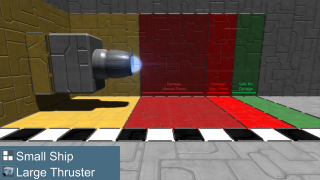Thruster
Thrusters are the primary means that all ships and even stations use to maneuver around. Thrusters only provide direct linear thrust in the direction away from the nozzle regardless of their physical position on the ship, they will not apply any torque or cause any rotation of the ship to any axis (see Gyroscope). As long as the thruster is directly connected to the Grid (not a sub-grid or attached via Landing Gear), they will provide thrust essentially from the center of mass so there is little restriction on placement. There are two major types of thrusters: Standard Thrusters, Ion based thrusters that use electricity as a fuel source to provide thrust and Hydrogen Thrusters, which use Hydrogen as a fuel which is comparatively much more powerful but also much more limited.
Before Update 1.105, Thrusters used to have two specific modes: a normal thrust and the inertial dampening thrust. Normal Thrust that is used when manually piloting with the keys and mouse or using the thrust override slider and an dampening thrust that is automatic providing 10x more force for 50% more electricity consumption. All Thrusters from large to small when inertial dampening is on and the ship is moving, will kick in and attempt to slow the ship to a stop. Due to this, ships were much more able to come to a complete stop than they were able to accelerate before that update.
Currently all Large ship thrusters do not have any special super-dampening capabilities beyond their rated maximum thrust and power consumption, while small ship thrusters only possess 5x thrust when dampening and do not seem require any more power or fuel while doing so.
Thrusters
| Thruster | Block size | Dimensions [size in m3] |
Maximum Thrust [KN] |
Mass [kg] |
Max Power Consumption [KW] |
Mass-to-Thrust [KN/Kg] |
Size-to-Thrust [KN/m3] |
Power-To-Thrust [KN/KW] |
Fuel Consumption [H/s] or [kg of U/s ] |
Max Thrust /w Dampening [KN] | |
|---|---|---|---|---|---|---|---|---|---|---|---|
| |
Large Thruster | |
3x4x2 [375 m3] | 3'600 | 43200 | 33600 | 0.0833 | 9.6 | 0.1071 | 0.0093 kg | Nil - no extra thrust |
| |
3x4x2 [3 m3] | 144 | 721 | 2400 | 0.1997 | 48 | 0.060 | 0.00067 kg | 720 | ||
| Small Thruster | |
1x2x1 [31.250 m3] | 288 | 4384 | 3360 | 0.0657 | 9.216 | 0.0857 | 0.00093 kg | Nil - no extra thrust | |
| |
1x2x1 [0.250m3] | 12 | 93 | 201 | 0.1290 | 48 | 59.7015 | 0.000058 kg | 60 | ||
| |
Large Hydrogen Thruster | |
3x3x3 [421.875 m3] | 6'000 | 6'940 | 10'000* | 0.8646 | 14.222 | n/a | 6,426.7 H | Nil - no extra thrust |
| |
3x3x3 [3.375 m3] | 400 | 1222 | 800* | 0.3273 | 118.5185 | n/a | 514.1 H | 2000 | ||
| Small Hydrogen Thruster | |
1x1x1 [15.625m3] | 900 | 1420 | 1700* | 0.6338 | 57.6 | n/a | 1,092.5 H | Nil - no extra thrust | |
| |
1x1x1 [0.125m3] | 82 | 334 | 170* | 0.2455 | 656 | n/a | 109.2 H | 410 | ||
- Dampening values only apply when Inertial Dampeners are activated and thrusters are not being fired manually, in addition while dampening the thrusters will not consume any more power or fuel than their rated maximum power consumption.
- All standard Electric-based thrusters will consume a minimum of 0.002 KW (2 Watts), even when not in use. Their power consumption and fuel consumption scales linearly with what percentage (as seen on the thrust override slider) the thruster is operating at.
- All Hydrogen-based Thrusters require a Conveyor connection to a source of Hydrogen such as an Oxygen Generator or a Hydrogen Tank. (*) Hydrogen based Thrusters despite having a 'power consumption' rating will not actually consume electrical power they ONLY consume Hydrogen from a hydrogen source accessed via conveyors. Their only electrical requirements will be for the hydrogen sources that store or make hydrogen and the Conveyor system. Each Hydrogen Thruster consumes a tiny amount of Hydrogen even if not active (as seen with its 'pilot light'), much like the minimum that electric-based thrusters have.
Thruster Damage
If 'Thruster Damage' is enabled for a map or server, thrusters will deal damage while active to any blocks directly behind within a certain distance with exception to small thrusters damaging large ship blocks, making it possible to build 'landing pads'. If this occurs, blocks adjacent to the block/s in "the line of fire" will also be damaged in a cross-pattern. If the block is too close to the thruster, this can even damage the thruster, causing it to explode. The "danger zone" varies in size based on the thrust being applied by the thruster. Large thrusters deal damage further than small thrusters. Likewise, thrusters on large ships deal damage further than those on small ships.
This table (and the images below it) indicate the damage distances for small and large thrusters and ships. They apply only to blocks directly behind the thruster, and do not account for damage to adjacent blocks.
| Damage Distance with Manual Thrust... |
...and with Max. Thrust (Dampeners) | ||||
| Blocks | Metres | Blocks | Metres | ||
| Small Ship | Small Thruster | 3 sb | 1.5m | 4 sb | 2.0m |
| Large Thruster | 5 sb | 2.5m | 7 sb | 3.5m | |
| Large Ship | Small Thruster | 2 lb | 5.0m | 3 lb | 7.5m |
| Large Thruster | 5 lb | 12.5m | 6 lb | 15.0m | |
- sb = small-ship blocks (0.5m each)
- lb = large-ship blocks (2.5m each)



